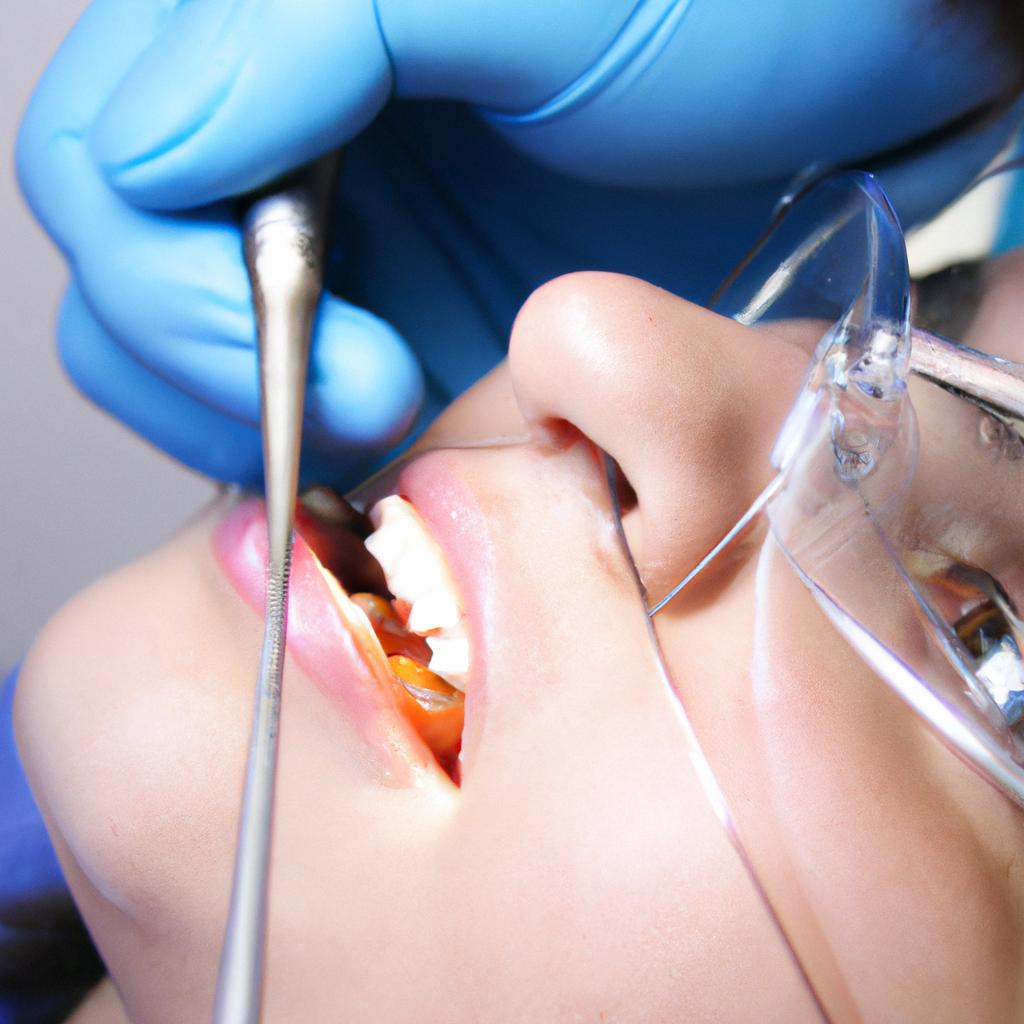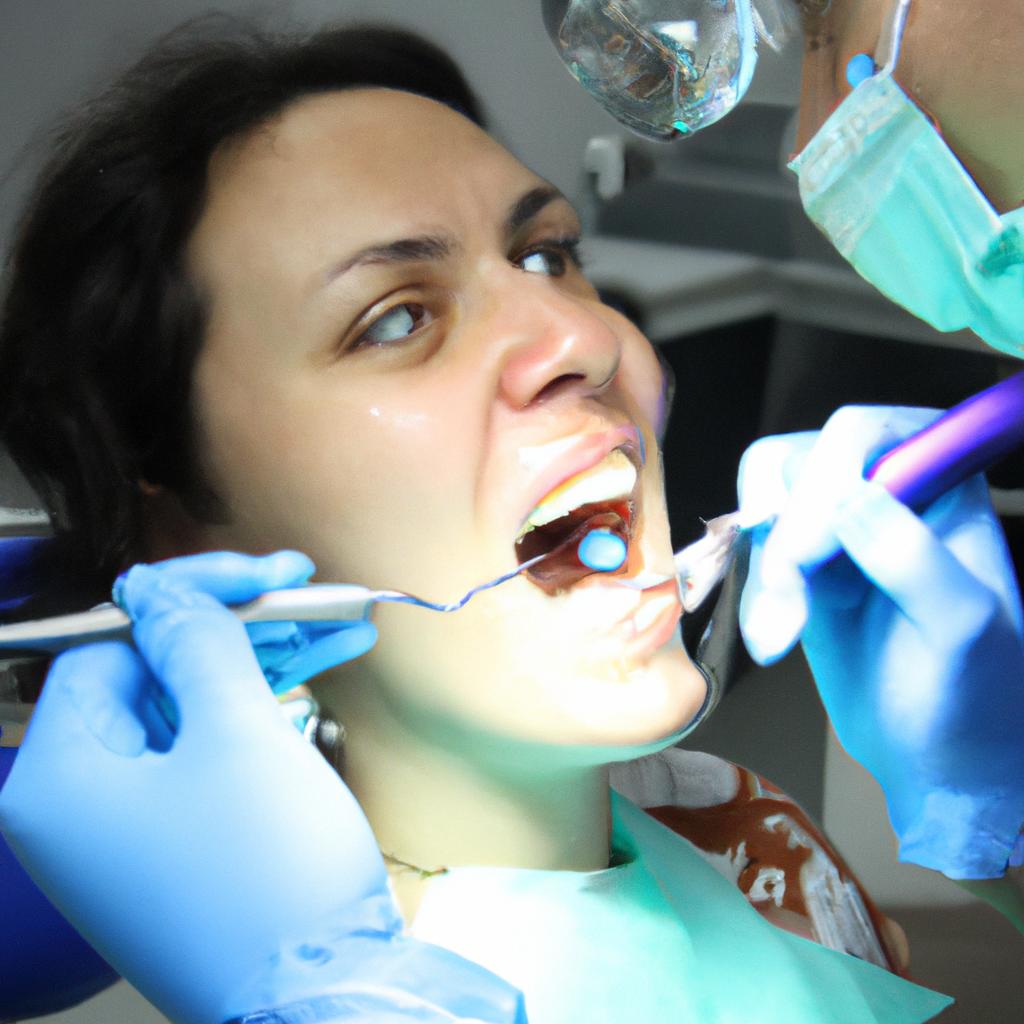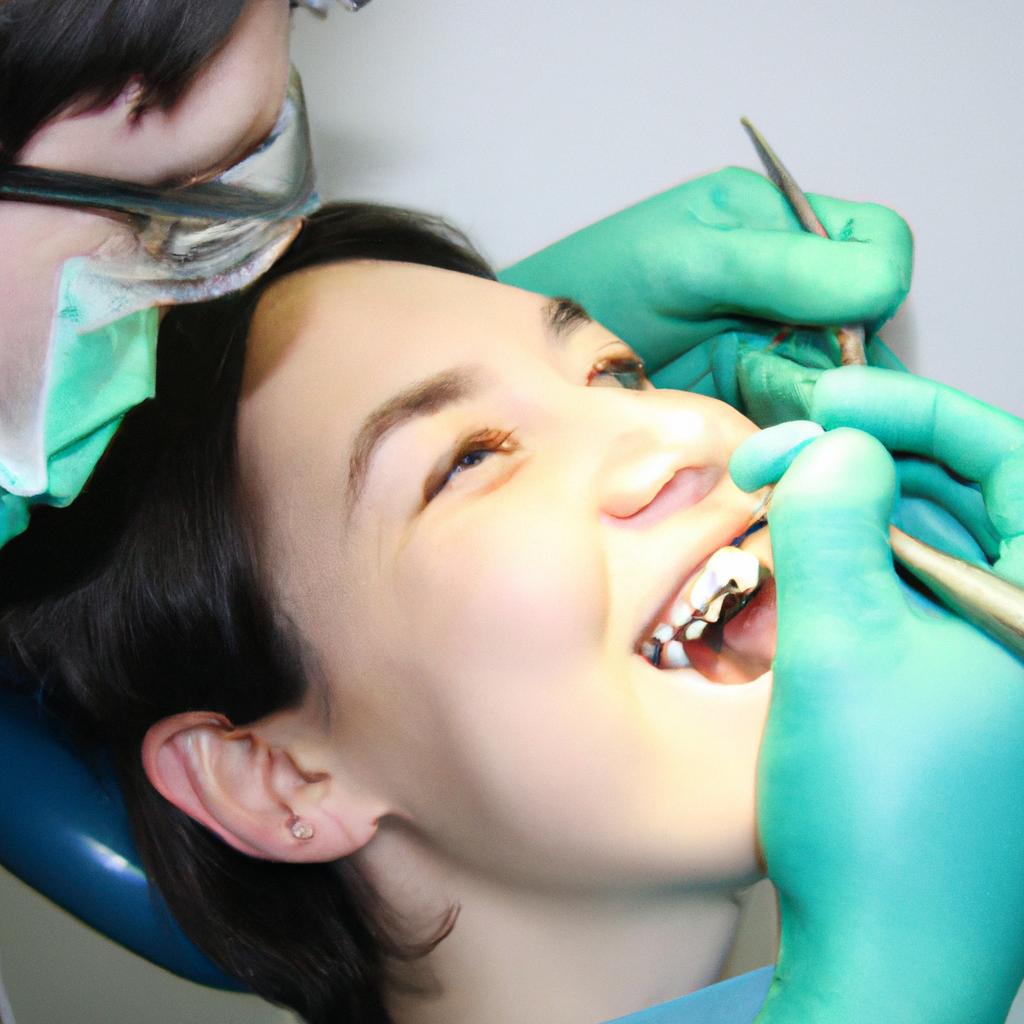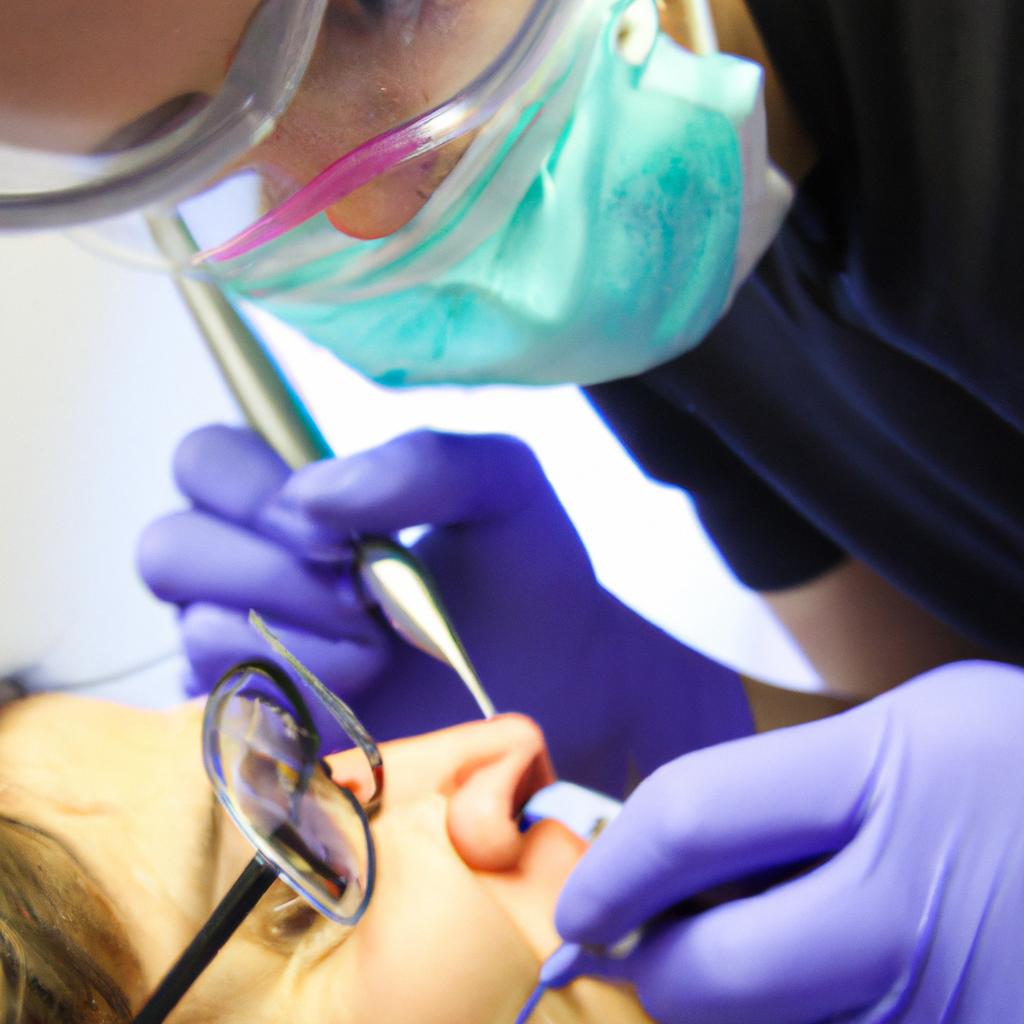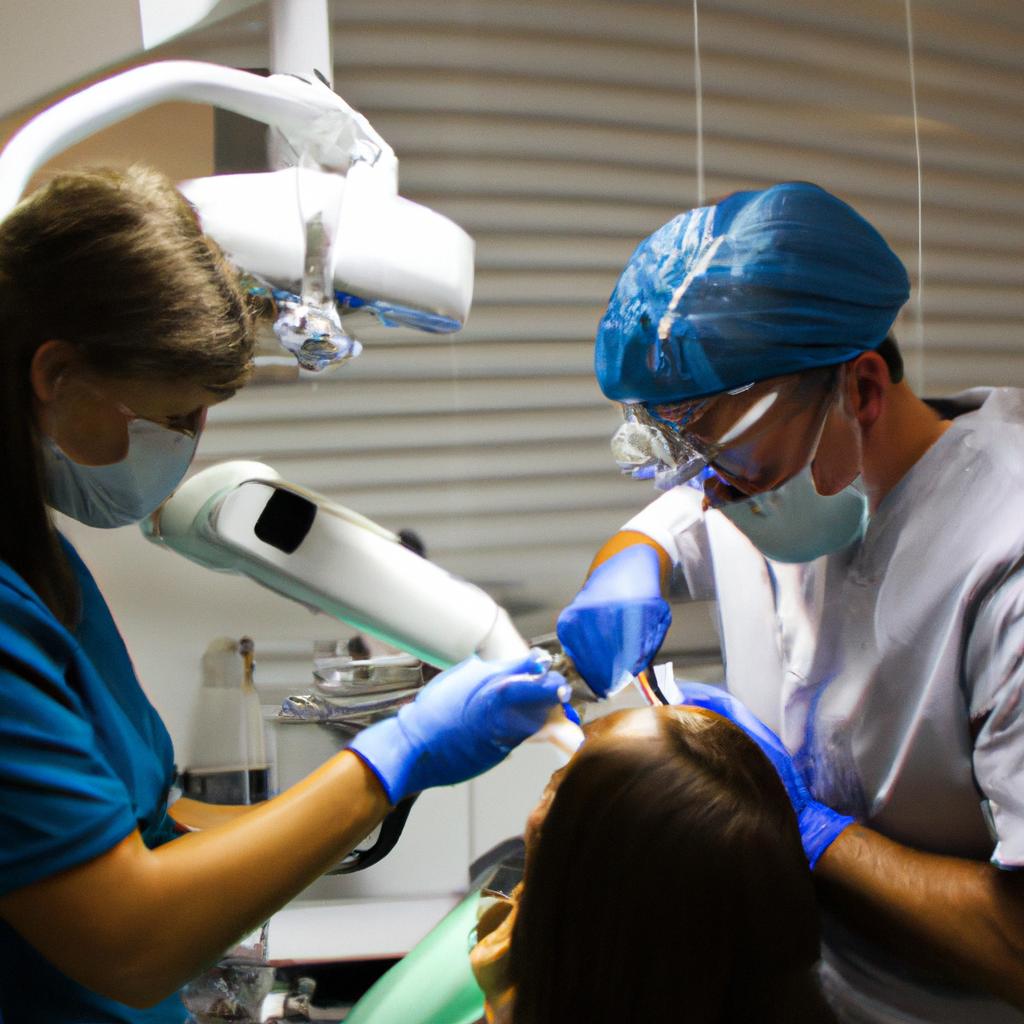Apexification in Endodontics: A Comprehensive Overview

Apexification is a crucial procedure in endodontics, aimed at achieving root apex closure and promoting the formation of a functional apical barrier. This comprehensive overview delves into the various aspects of apexification, discussing its indications, techniques, and outcomes. To illustrate the significance of this procedure, consider a hypothetical case study: A 25-year-old patient presents with an immature permanent tooth that has experienced irreversible pulpitis due to trauma. In such cases where root development is incomplete, apexification becomes essential for preserving tooth vitality and preventing further complications.
The article will begin by exploring the fundamental principles behind apexification, including the rationale for inducing the formation of an apical barrier and promoting continued root development. It will then delve into different techniques used to achieve these objectives, such as using calcium hydroxide or mineral trioxide aggregate (MTA) as intracanal medicaments. The advantages and limitations of each technique will be thoroughly examined to provide clinicians with evidence-based guidance in their decision-making process.
Furthermore, this comprehensive overview will discuss recent advancements in apexification procedures, including regenerative approaches that aim to promote tissue regeneration within the root canal space. By evaluating clinical studies and systematic reviews on apexification outcomes, this article seeks to shed light on the efficacy and long-term success rates of apexification procedures. This will help clinicians understand the expected outcomes and potential complications associated with this treatment modality.
Moreover, the article will address key considerations in patient selection for apexification, including age, tooth maturity, and pulpal status. It will also discuss possible alternative treatment options in cases where apexification may not be feasible or appropriate.
In addition to discussing the technical aspects of apexification, this overview aims to provide a comprehensive understanding of the biological processes involved in root development and apical closure. By addressing the cellular and molecular mechanisms underlying these processes, clinicians can gain insights into how apexification promotes continued root development and enhances tooth vitality.
Overall, this article serves as a valuable resource for endodontists and general practitioners alike who are seeking a deeper understanding of apexification techniques, indications, outcomes, and advancements. By synthesizing current evidence-based research on this topic, it offers practical guidance that can inform clinical decision-making and improve patient outcomes.
Definition of Apexification
Definition of Apexification
Apexification is a vital procedure in endodontics that aims to induce the formation of an apical barrier or root-end closure. This technique is typically employed when the root development in immature permanent teeth has been arrested due to trauma, caries, or iatrogenic factors (such as over-instrumentation). By creating an artificial apical barrier, apexification facilitates the continuation of root maturation and strengthens the tooth structure.
To better understand this process, consider the case study of a 12-year-old patient who had suffered a traumatic dental injury resulting in pulpal necrosis and incomplete root development. In this scenario, apexification was performed using calcium hydroxide as an intracanal medicament to stimulate hard tissue formation at the apex. Over time, this induced mineralization led to the establishment of an apical barrier, allowing for proper root canal obturation and subsequent restoration.
The significance of apexification can be summarized through its benefits:
- Preservation of pulp vitality: Apexification promotes continued dentinogenesis by providing a favorable environment for pulp cells to differentiate into odontoblast-like cells.
- Strengthening of tooth structure: The induction of an apical barrier enhances resistance against fractures and reduces susceptibility to coronal leakage.
- Prevention of infection: By sealing off the open apex with mineralized tissue, apexification minimizes the risk of bacterial infiltration into the root canal system.
- Promotion of successful endodontic treatment outcomes: Establishing an apical barrier enables effective shaping and obturation during root canal therapy while enhancing long-term prognosis.
| Benefits |
|---|
| Preservation of pulp vitality |
| Prevention of infection |
In conclusion, apexification plays a crucial role in managing non-vital immature permanent teeth. Through its ability to induce the formation of an apical barrier, this procedure not only promotes continued root development but also strengthens the tooth structure and improves treatment outcomes. In the following section, we will explore the indications for apexification, shedding light on when this technique should be considered in clinical practice.
Indications for Apexification
Apexification is a critical procedure in endodontics that aims to promote the formation of a hard tissue barrier at the apex of an immature, non-vital tooth. This process becomes necessary when the pulp has been severely damaged or infected, often resulting from traumatic injuries or deep carious lesions. To provide further clarity on this topic, we will now explore the indications for apexification.
Indications for Apexification:
One example that illustrates the need for apexification involves a 12-year-old patient who experienced trauma to their maxillary central incisor. The dental examination revealed incomplete root development and apical pathology as a result of the injury. In such cases where teeth with open apices are compromised due to infection or necrosis, apexification serves as an effective treatment option.
The decision to perform apexification relies on several factors, including:
- Patient age: Apexification is typically indicated in younger patients whose permanent dentition is yet to fully develop.
- Presence of periapical pathology: When radiographic evidence confirms periapical disease subsequent to pulpal necrosis, apexification can serve as an appropriate course of action.
- Non-vitality of the tooth: A non-responsive pulp indicates irreversible damage and necessitates apexification.
- Presence of an open apex: Teeth with incompletely formed roots require stimulation for continued root development and strengthening.
To better understand these indications, consider Table 1 below which summarizes key criteria influencing the decision-making process surrounding apexification:
Table 1: Indications for Apexification
| Criteria | Indication |
|---|---|
| Young patient | Permanent dentition not fully developed |
| Periapical pathology | Radiographic evidence confirming periapical disease |
| Non-vitality | Lack of response from pulp vitality tests |
| Open apex | Incompletely formed roots requiring stimulation |
In conclusion, apexification is indicated in cases where young patients present with non-vital teeth, periapical pathology, and incomplete root development. By understanding these indications, dental professionals can make informed decisions regarding the appropriate treatment approach for each patient.
Moving forward to the subsequent section about “Procedure for Apexification,” it is important to explore the steps involved in this process to gain a comprehensive understanding of its execution.
Procedure for Apexification
In the previous section, we discussed the concept of apexification and its role in endodontics. Now, let us delve into the indications for this procedure. To better understand these indications, consider the case of a 15-year-old patient who experienced dental trauma resulting in pulpal necrosis and incomplete root development.
Apexification is typically indicated when dealing with immature permanent teeth that have suffered traumatic injuries or carious exposures leading to pulp necrosis. In our hypothetical case study, the patient’s tooth exhibited an open apex due to incomplete root formation. This condition poses a challenge as traditional endodontic procedures may not be suitable or effective in such cases.
To further illustrate the need for apexification, below are some common scenarios where this treatment approach is warranted:
- Teeth with apical periodontitis: These are cases where there is inflammation and infection at the apex of a tooth.
- Non-vital immature teeth: When pulp necrosis occurs in immature teeth that still possess an open apex.
- Traumatic injuries causing pulp necrosis: Dental trauma can lead to avulsion, intrusion, luxation or lateral luxation of teeth, subsequently causing pulpal necrosis.
- Re-treatment after failed initial therapy: If conventional root canal treatment has been unsuccessful or cannot be performed on a tooth with an open apex.
Now that we have explored various situations where apexification becomes necessary, it is important to note that each case requires careful evaluation by an endodontist to determine whether this technique is appropriate and advantageous over other available options.
Below is a table summarizing key clinical considerations when deciding if apexification should be pursued:
| Clinical Considerations | Advantages | Disadvantages |
|---|---|---|
| Open apex | Facilitates healing through artificial barrier formation | Extended treatment duration |
| Immature roots | Promotes continued root maturation and closure of apex | Risk of root fracture due to increased brittleness |
| Presence of apical periodontitis | Resolves infection, eliminating risk of further complications | Potential for persistent or recurrent infection |
| Failed prior treatment | Provides an alternative approach for managing unresolved cases | Limited long-term predictability |
In summary, apexification is indicated in specific clinical scenarios involving immature permanent teeth with open apices, pulp necrosis, or failed initial endodontic therapy. The decision to pursue this technique should be based on careful evaluation by the endodontist considering factors such as tooth maturity, presence of infection, and potential advantages and disadvantages associated with the procedure.
Moving forward into the next section about “Materials used in Apexification,” we will explore the various substances employed during this process to achieve optimal outcomes.
Materials used in Apexification
Having discussed the procedure for apexification, let us now delve into the essential materials that are commonly employed during this endodontic treatment. Understanding these materials is crucial as they play a pivotal role in achieving successful outcomes and promoting healing of the periapical tissues.
Materials Used in Apexification:
To facilitate apexification, various materials can be utilized based on their specific properties and clinical requirements. These materials serve multiple purposes, such as creating an apical barrier to prevent extrusion of filling material and providing support for future root canal obturation. Let’s explore some of the frequently used materials in apexification procedures:
- Calcium hydroxide (Ca(OH)2): Widely recognized as a gold standard material due to its antimicrobial activity and ability to induce hard tissue formation within the root canal space.
- Mineral trioxide aggregate (MTA): A biocompatible material known for its sealing ability and excellent biological response, making it suitable for use in perforation repairs and apexification.
- Biodentine: A newer bioactive cement with similar properties to MTA but offers faster setting time, which may enhance workflow efficiency without compromising patient care.
- Collagen-based matrix scaffold: Often used as a carrier or scaffold material to promote cellular ingrowth and stimulate regeneration within the periapical region.
These materials provide clinicians with versatile options when performing apexification procedures. However, it is important to consider individual cases’ unique characteristics before selecting the most appropriate material.
In addition to understanding the different materials involved in apexification, it is also essential to recognize their limitations, potential complications arising from their usage, and alternative techniques available for challenging cases. In the subsequent section about “Complications of Apexification,” we will explore these aspects further.
By familiarizing ourselves with both traditional and innovative materials employed during apexification procedures, we can optimize treatment outcomes and enhance the overall success rates in managing endodontic cases.
Complications of Apexification
Apexification is a commonly employed technique in endodontics for the treatment of immature permanent teeth with necrotic pulps. In this procedure, the objective is to promote the formation of an apical barrier or root-end closure using different materials. A wide array of materials have been utilized over the years to achieve successful apexification outcomes.
One material frequently used during apexification procedures is calcium hydroxide (Ca(OH)2). Its alkaline nature and ability to stimulate hard tissue deposition make it an excellent choice for inducing a favorable environment for apexogenesis. Ca(OH)2 acts by promoting the release of cytokines from periapical tissues, which results in dentin bridge formation at the apical region. However, its drawbacks include long treatment duration and potential weakening of the root structure due to extended exposure.
Another alternative material employed in apexification is mineral trioxide aggregate (MTA). MTA has gained popularity because of its biocompatibility, sealing ability, and capacity to induce rapid healing. It offers superior properties such as good handling characteristics, hydraulic behavior allowing easy adaptation into irregularities, and bioactivity that stimulates cementum-like tissue formation. Additionally, MTA exhibits antimicrobial effects against various microorganisms commonly associated with endodontic infections.
Despite these advantages, some complications may arise during apexification procedures. These can range from minor challenges to more severe issues that impact treatment outcomes. The four main complications encountered are:
- Perforation: Accidental perforations may occur during access cavity preparation or instrumentation procedures.
- Overfilling/Underfilling: Incorrect placement or inadequate filling of the canal space leading to compromised seal.
- Dislodgement of Material: Loss or displacement of materials applied within the canal system.
- Root Fracture: Excessive force applied during instrumentation resulting in root fracture.
| Complication | Description |
|---|---|
| Perforation | Accidental creation of a hole in the root structure during endodontic treatment procedures. |
| Overfilling/Underfilling | Improper placement or inadequate filling of the canal space leading to compromised seal. |
| Dislodgement of Material | Loss or displacement of materials applied within the canal system. |
| Root Fracture | Excessive force applied during instrumentation resulting in fracture of the root structure. |
As apexification is an established technique for managing immature permanent teeth with necrotic pulps, it is vital to understand both the materials used and potential complications that may arise during its implementation. In the subsequent section, we will explore alternatives to apexification, providing further insights into other treatment options available for clinicians.
Having discussed the various materials utilized in apexification as well as potential complications, let us now delve into alternative treatments that can be considered when apexification might not be suitable for certain cases.
Alternatives to Apexification
Complications of Apexification and the Need for Alternatives
After exploring the various complications that can arise from apexification, it becomes evident that alternatives to this treatment approach are necessary. One such alternative is apexogenesis, which promotes continued root development in immature teeth by preserving healthy pulp tissue. This technique has shown promising results in cases where apexification may not be feasible or desirable.
To illustrate the importance of considering alternatives, let us consider a hypothetical case study. A 10-year-old patient presents with a traumatic dental injury resulting in incomplete root formation of an upper central incisor. Traditionally, apexification would have been recommended to induce apical closure and strengthen the tooth structure. However, recent research suggests that apexogenesis could provide a more favorable outcome by allowing natural root maturation to occur while maintaining pulpal vitality.
When evaluating potential alternatives to apexification, several factors must be taken into account:
- Age of the patient: Younger patients who have not completed root formation may benefit from techniques that promote further growth.
- Presence of infection: In cases where there is active infection or inflammatory response within the pulp, considerations should be made regarding appropriate management strategies.
- Long-term prognosis: Assessing the overall health and stability of the tooth is crucial when deciding between different treatment options.
- Patient preferences: It is important to involve patients and their guardians in decision-making processes, taking into consideration their values and desires for long-term oral health.
In addition to these considerations, it is valuable to compare apexification with other available treatment modalities using objective criteria. The table below provides a comparative analysis of key aspects related to apexification and its alternatives:
| Treatment Modality | Apical Closure | Root Maturation | Pulp Vitality |
|---|---|---|---|
| Apexification | Achieved | Limited | Non-vital |
| Apexogenesis | Not achieved | Enhanced | Preserved |
| Regenerative Endodontics | Possible | Enhanced | Preserved |
By evaluating the potential complications associated with apexification and exploring alternative treatment options, clinicians can make informed decisions that prioritize both the long-term health of patients’ teeth and their overall well-being. The choice between apexification and alternatives like apexogenesis or regenerative endodontics should be tailored to each individual case, considering patient-specific factors and future prognosis.
In summary, it is crucial for practitioners in endodontics to recognize the limitations and possible drawbacks of apexification. By embracing alternatives such as apexogenesis and regenerative endodontics when appropriate, clinicians can optimize outcomes while preserving pulp vitality and promoting natural root development in young patients.

